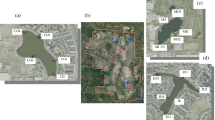Abstract
This study was performed to find the influence of storm-water sewer overflows on stream water quality and to track nonpoint fecal pollutant sources. Based on the analysis of BOD5, CODcr, TN, TP, coliform bacteria and heavy metals from storm-water sewer overflows into the Ansan stream in Korea, during both dry and wet weather, it was found that the storm-water sewer overflows adversely affected stream water quality. Cd concentrations, especially, exceeded the standard of water quality needed for the health of human beings; also, a number of coliform bacteria were also found. TN concentrations in the upper stream were higher than those of other storm-water overflow points, and fecal bacteria concentrations mid- and downstream were higher than those of the upper stream. Antibiotic Resistance Analysis (ARA) was conducted to find more fundamental pollutant sources. ARA statistically confirmed livestock as a major source of the coliform bacteria in the upper stream, verifying that the major sources of pollution are fertilizers and livestock farming. ARA also showed that human beings were statistically confirmed as a major source of coliform bacteria in the mid- and downstream sections, which implies that a breach in the sewer line mid- and downstream could be present. Therefore, ARA was confirmed to be an effective non-point source-tracking tool in streams, with high reliability and efficiency.
Similar content being viewed by others
References
APHA (2005). Standard method for the examination of water and wastewater, American Public Health Association, New York.
Barrett, M. E., Irish, Jr. L. B., Malina, Jr. J. F., and Charbeneau, R. J. (1998). “Characterization of highway runoff in Austin, Texas, area.” Journal of Environmental Engineering, Vol. 123, No. 2, pp. 131–137.
Beacher, K. D., Schnoebelen, D. J., and Akers, K. K. B. (2000). “Nutrients discharged to the Mississippi river from eastern Iowa watershed.” Journal of the American Water Resources Association, Vol. 36, No. 1, pp. 161–173.
Cynthia, L. M., Klaas, B., Rick, N., and Asit, M. (2004). “Source tracking fecal bacteria in water: A critical review of current methods.” Journal of Environmental Management, Vol. 73, No. 1, pp. 71–79.
Hamilton, W. P., Kim, M., and Thackston, E. L. (2005). “Comparison of commercially available Escherichia coli enumeration tests: Implications for attaining water quality standards.” Water Research, Vol. 39, No. 20, pp. 4869–4878.
Harwood, V. J., Whitlock, J., and Withington, V. (2000). “Classification of the antibiotic resistance patterns of indicator bacteria by discriminant analysis: Use in predicting the source of fecal contamination in subtropical waters.” Applied and Environmental Microbiology, Vol. 66, No. 9, pp. 3698–3704.
Nagels, J. W., Davies-Colloy, R. J., Donnidon, A. M., and Muirhead, R. W. (2002) “Fecal contamination over flood events in a pastoral agricultural stream in New Zealand.” Water Science and Technology, Vol. 45, No. 12, pp. 45–52.
Sandra, L. M., Erika, J. H., Morgan, M. D., Meredith, V. D., Josh, H., and Caitlin, O. S. (2007). “Distribution and fate of Escherichia coli in lake Michigan following contamination with urban stormwater and combined sewer overflows.” Journal of Great Lakes Research, Vol. 33, No. 3, pp. 566–580.
Signor, R. S., Roser, D. J., Ashbolt, N. J. and Ball, J. E. (2005). “Quantifying the impact of runoff events on microbiological contaminant concentrations entering surface drinking source waters.” Journal of Water and Health, Vol. 3, No. 4, pp. 453–468.
Sinton, L. W., Donnison, A. M. and Hastie, C. M. (1993). “Faecal streptococci as faecal pollution indicators: A review. II, Sanitary significance, survival, and use.” New Zealand Journal of Marine and Freshwater Research, Vol. 27, No. 1, pp. 117–137.
Wiggins, B. A., Andrews, R. W., Conway, R. A., Corr, C. L., Dobratz, E. J., Dougherty, D. P., Eppard, J. R., Knupp, S. R., Limjoco, M. C., Mettenburd, J. M., Rinehardt, J. M., Sonsino, J., Torrijos, R. L., and Zimmerman, M. E. (1999). “Use of antibiotic resistance analysis to identify nonpoint sources of fecal pollution.” Applied and Environmental Microbiology, Vol. 65, No. 8, pp. 3483–3486.
Author information
Authors and Affiliations
Corresponding author
Rights and permissions
About this article
Cite this article
Lee, S., Lee, J. & Kim, M. The influence of storm-water sewer overflows on stream water quality and source tracking of fecal contamination. KSCE J Civ Eng 16, 39–44 (2012). https://doi.org/10.1007/s12205-012-1198-0
Received:
Revised:
Accepted:
Published:
Issue Date:
DOI: https://doi.org/10.1007/s12205-012-1198-0




